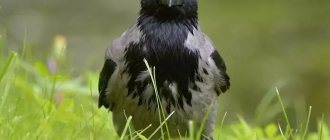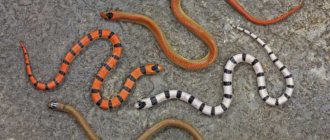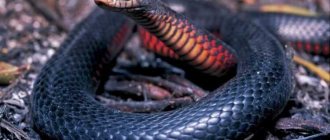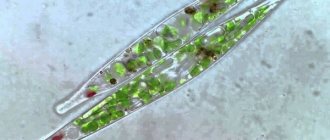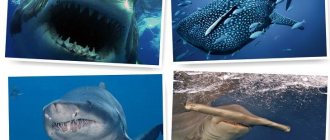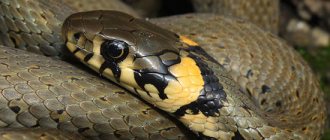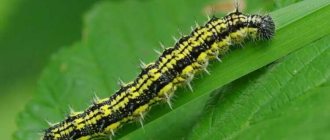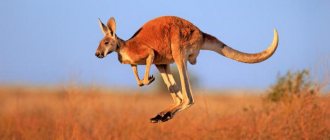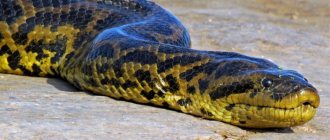Review author: “ZooVita”
Today, more than 1,000 species of reptiles are known. Each species differs in its appearance, diet, habitat and coloring. Vivid representatives of flora and fauna are considered dangerous to the human and animal body.
The fact is that the internal glands of snakes secrete a toxic liquid that enters the bloodstream when bitten. Snake venom provokes rapid clotting of blood cells and further death of the contact person.
Green snakes are especially popular among researchers. Let's take a closer look at the representatives with a characteristic shade.
What does a green boiga look like?
The reptile's body reaches 150 cm in length. This is a fairly large green snake. Her thin body resembles a triangular cross-section. The eye color of the individual is blue or turquoise. Body color is green with shades of pink or blue. The skin of younger representatives is slightly lighter.
The venom of the green boga is not as poisonous as that of the mangrove boga.
Literature
- Boie, F. 1827 Bemerkungen über Merrem's Versuch eines Systems der Amphibien, 1. Lieferung: Ophidier. Isis van Oken, Jena, 20: 508–566.
- Boulenger, G. A. 1894 On the herpetological fauna of Palawan and Balabac. Ann. Mag. Nat. Hist. (6) 14: 81-90
- Dowling, Herndon G. 1958 A taxonomic study of the ratsnakes VI. Validation of the genera Gonyosoma Wagler and Elaphe Fitzinger Copeia 1958 (1): 29-40
- Gray, J. E. 1849 Description of three new genera and species of snakes. Ann. Mag. Nat. Hist. (2) 4: 246—248
Habitat
The snake lives in a humid environment. The tropics in southern Asia are suitable for her. Boiga also lives in the south of Vietnam and Cambodia.
Links
- Wogan, G., Vogel, G., Thy, N., Nguyen, TQ, Demegillo, A., Diesmos, AC & Gonzalez, JC 2012. [www.iucnredlist.org/details/183196/0 Gonyosoma oxycephalum
]. In: IUCN 2012. IUCN Red List of Threatened Species. Version 2012.2. - [www.ratsnakefoundation.org/index.php/ratsnake-species/asian-ratsnakes/71-gonyosoma-oxycephalum Gonyosoma oxycephalum - Red Tailed Racer - CAPTIVE CARE NOTES - Ratsnake Foundation]
- [www.ratsnakefoundation.org/index.php/articles/asian-ratsnakes/189—gonyosoma-oxycephalum Maintaining the Red Tailed Tree Racer, Gonyosoma oxycephalum—Ratsnake Foundation]
Green snake venom
Boiga is very poisonous. One bite is enough to cause a tumor to form. The consequences are vomiting, chills, nausea, dizziness.
Fortunately, no deaths occur. After two or three days the person returns to his normal state. The small teeth of boiga are carriers of poison.
Green Boyga Foods
Green boiga is unpretentious in nutrition. She usually eats small rodents, frogs, birds, and insects. One serving size is quite large. A newborn snake eats a baby mouse or a whole chicken.
When kept at home, the green boyga is fed to lizards, frogs and birds.
Contents in home terrariums
When purchasing these representatives, it is necessary to take into account the conditions of their maintenance, which will allow them to extend their life cycle. To do this, it is necessary to take into account a number of requirements:
- Volumetric terrarium;
- Temperature conditions exceeding 30 degrees;
- The humidity level should reach up to 95%;
- The resting places of the serpents are decorated with dry branches;
- The bottom of the terrarium is covered with coconut shavings or sawdust.
During the incubation period, the female must be placed in a separate enclosure. In one clutch in captivity, it can produce up to 10 eggs. After this, the egg clutch is placed in a small container, the humidity inside of which should reach 25-29 degrees. The incubation period can vary between 80-150 days.
Green mamba
The green mamba snake is one of the most dangerous in the world. The green snake has another name - the devil. She was given this nickname due to the fact that she attacks the victim with lightning speed and without warning.
Note!
- Domestic turtles - the most popular species, cultivation features, tips for care and maintenance (115 photos + video)
- Indian snakes: sacred, poisonous, most common and dangerous types of Indian snakes and their names (130 photos)
- Small snakes - an overview of popular and rare species, habitats, food and names of snakes (115 photos)
Green reptiles
There are several names for green snakes. This list includes:
- Herbaceous green whipweed;
- Green runner;
- Green Mamba;
- Common viper;
- Hampton's Snake;
- Chinese big;
- Short green.
What does a green mamba look like?
The body of the green mamba reaches a length of almost one hundred and fifty centimeters. The color of the scales is usually dark green.
The shape of the head is rectangular, slightly separated from the body. Not all of a snake's teeth are poisonous. Only the two large front teeth carry the deadly substance. The reptile's scales shimmer in shades of yellow and blue.
There are also small species of green snakes. As a rule, these are young representatives. They are only seven centimeters long. As the mamba matures, it becomes larger and longer.
An excerpt characterizing the Green Snake
- Go, go! - Anatole shouted. Balaga was about to leave the room. “No, stop,” said Anatole. - Close the doors, I need to sit down. Like this. “They closed the doors and everyone sat down. - Well, now march, guys! - Anatole said standing up. The footman Joseph handed Anatoly a bag and a saber, and everyone went out into the hall. -Where is the fur coat? - said Dolokhov. - Hey, Ignatka! Go to Matryona Matveevna, ask for a fur coat, a sable cloak. “I heard how they were taking away,” Dolokhov said with a wink. - After all, she will jump out neither alive nor dead, in what she was sitting at home; you hesitate a little, there are tears, and dad, and mom, and now she’s cold and back - and you immediately take him into a fur coat and carry him into the sleigh. The footman brought a woman's fox cloak. - Fool, I told you sable. Hey, Matryoshka, sable! – he shouted so that his voice was heard far across the rooms. A beautiful, thin and pale gypsy woman, with shiny black eyes and black, curly, bluish-tinged hair, in a red shawl, ran out with a sable cloak on her arm. “Well, I’m not sorry, you take it,” she said, apparently timid in front of her master and regretting the cloak. Dolokhov, without answering her, took the fur coat, threw it on Matryosha and wrapped her up. “That’s it,” said Dolokhov. “And then like this,” he said, and lifted the collar near her head, leaving it only slightly open in front of her face. - Then like this, see? - and he moved Anatole’s head to the hole left by the collar, from which Matryosha’s brilliant smile could be seen. “Well, goodbye, Matryosha,” said Anatole, kissing her. - Eh, my revelry is over here! Bow to Steshka. Well, goodbye! Goodbye, Matryosha; wish me happiness. “Well, God grant you, prince, great happiness,” said Matryosha, with her gypsy accent. There were two troikas standing at the porch, two young coachmen were holding them. Balaga sat down on the front three, and, raising his elbows high, slowly took apart the reins. Anatol and Dolokhov sat down with him. Makarin, Khvostikov and the footman sat in the other three. - Are you ready, or what? – asked Balaga. - Let go! - he shouted, wrapping the reins around his hands, and the troika rushed down Nikitsky Boulevard. - Whoa! Come on, hey!... Whoa, - you could only hear the cry of Balaga and the young man sitting on the box. On Arbat Square, the troika hit a carriage, something crackled, a scream was heard, and the troika flew down Arbat. Having given two ends along Podnovinsky, Balaga began to hold back and, returning back, stopped the horses at the intersection of Staraya Konyushennaya. The good fellow jumped down to hold the horses' bridles, Anatol and Dolokhov walked along the sidewalk. Approaching the gate, Dolokhov whistled. The whistle responded to him and after that the maid ran out. “Go into the yard, otherwise it’s obvious he’ll come out now,” she said. Dolokhov remained at the gate. Anatole followed the maid into the yard, turned the corner and ran onto the porch. Gavrilo, Marya Dmitrievna’s huge traveling footman, met Anatoly. “Please see the lady,” the footman said in a deep voice, blocking the way from the door. - Which lady? Who are you? – Anatole asked in a breathless whisper. - Please, I've been ordered to bring him. - Kuragin! back,” Dolokhov shouted. - Treason! Back! Dolokhov, at the gate where he stopped, was struggling with the janitor, who was trying to lock the gate behind Anatoly as he entered. Dolokhov, with his last effort, pushed the janitor away and, grabbing the hand of Anatoly as he ran out, pulled him out the gate and ran with him back to the troika. Marya Dmitrievna, finding a tearful Sonya in the corridor, forced her to confess everything. Having intercepted Natasha’s note and read it, Marya Dmitrievna, with the note in her hand, went up to Natasha. “Bastard, shameless,” she told her. - I don’t want to hear anything! - Pushing away Natasha, who was looking at her with surprised but dry eyes, she locked it and ordered the janitor to let through the gate those people who would come that evening, but not to let them out, and ordered the footman to bring these people to her, sat down in the living room, waiting kidnappers. When Gavrilo came to report to Marya Dmitrievna that the people who had come had run away, she stood up with a frown and folded her hands back, walked around the rooms for a long time, thinking about what she should do. At 12 o'clock at night, feeling the key in her pocket, she went to Natasha's room. Sonya sat in the corridor, sobbing.
Green Mamba Lifestyle
The reptile does not often descend from the branches. She feels great surrounded by foliage. Thanks to the green coloration of the body, the snake remains unnoticed by predators. Mamba sleeps, eats, and even reproduces in trees.
By nature, the green mamba is not very aggressive, but very timid. The time of attack on the victim falls during the day, although it is almost impossible to see her during daylight hours. The reptile begins to hunt only when threatened with death.
Mamba constantly changes his place of residence. She climbs trees, always stopping at different ones.
Snake venom
Green snake venom is very toxic. The cobra has a less dangerous lethal substance.
A mamba can inflict several bites at once. And they all lead to death. According to statistics, an average of forty people die per year in African provinces.
Despite all the “negative” aspects, some people breed such snakes.
Recommendations
- " Dendroaspis angusticeps
". Integrated Taxonomic Information System. Retrieved October 30, 2012. - Uetz, Peter; Hallermann, Jacob. " Dendroaspis angusticeps
(SMITH, 1849)."
Reptile Database
. Reptarium Association. Retrieved February 17, 2012. - Smith, Andrew (1849). Illustrations of South African zoology, reptiles
. Volume 4. London: Smith, Elder and Company. Table 70. - de Vaan, Michel (2018) [2008]. An Etymological Dictionary of Latin and Other Italic Languages
. Boston: Leiden. paragraph 42. ISBN 978-90-04-16797-1. - Hall, Whitmore (1861). The main roots and derivatives of the Latin language, with a demonstration of their incorporation into the English language
. London: Longman, Green, Longman & Roberts. paragraph 153. - Gunther, Albert (1865). "Fourth report of new species of snakes in the collection of the British Museum". Annals and Journal of Natural History
.
Episode 3. 15
(86): 89–98 [98]. Doi:10.1080/00222936508681770. - ^ a bc Bates
, Michael F.;
Branch, William R.; Bauer, Aaron M; Burger, Marius; Marais, Johan; Alexander, Graham; de Villiers, Marien S. (2014). Atlas and Red List of Reptiles of South Africa, Lesotho and Swaziland
. Pretoria: South African National Biodiversity Institute, Pretoria. p. 397. ISBN 978-1-919976-96-9. - Boulenger, George Albert (1896). Catalog of Snakes in the British Museum (Natural History)
. Printed on behalf of the Board of Trustees of the British Natural History Museum. Department of Zoology. item 437. - FitzSimons, W. (1946). "Notes on some South African snakes, including a description of the new subspecies Xenocalamus
."
Chronicle of the Transvaal Museum
.
20
: 379–393 [392–393]. - Haagner, G. V.; Morgan, D. R. (1993). "Conservation and distribution of the Black Mamba Dendroaspis polylepis
at the Manyeleti Reptile Centre, Eastern Transvaal."
International Yearbook of Zoos
.
32
(1):191–196. Doi:10.1111/j.1748-1090.1993.tb03534.x. - Loveridge, Arthur (1950). "The Green and Black Mambas of East Africa." Journal of the Natural History Society of East Africa
.
19
(5): 251–252. - Figueroa, A.; McKelvy, A.D.; Grismer, L.L.; Bell, C. D.; Lailvo, S. P. (2016). "Species-level phylogeny of modern snakes with description of a new subfamily and genus of colubrids." PLOS ONE
.
11
(9):e0161070. Bibcode:2016PLoSO..1161070F. Doi:10.1371/journal.pone.0161070. PMC 5014348. PMID 27603205. - ^ a b
Ainsworth, Stewart;
Petras, Daniel; Engmark, Mikael; Süssmuth, Roderich D.; Whiteley, Gareth; Albulescu, Laura-Oana; Kazanjian, Talin D.; Wagstaff, Simon C.; Rowley, Paul; Wüster, Wolfgang; Dorrestein, Pieter C.; Arias, Ana Silvia; Gutiérrez, José M.; Harrison, Robert A.; Casewell, Nicholas R.; Calvet, Juan J. (2018). "The medical threat of mamba poisoning in sub-Saharan Africa, identified through analysis of venom composition, toxicity, and antivenom for the full range of available antivenoms." Journal of Proteomics
.
172
: 173–189 [178]. Doi:10.1016/j.jprot.2017.08.016. PMID 28843532. - ^ a b c d e
"
Dendroaspis angusticeps
".
WCH Clinical Toxinology Resource
. University of Adelaide. Retrieved April 26, 2014. - ^ a b c d f f
FitzSimons, Vivian F. M. (1970).
A Field Guide to the Snakes of South Africa
. HarperCollins. pp. 169–170. ISBN 978-0-00-212146-0. - ^ a b c d f g gram h i j
Marais, Jean (2004).
The Complete Guide to South Africa's Snakes
. Cape Town: Random House Struik Publishers. pp. 98–99. ISBN 978-1-8-6872-932-6. - ^ a b c d f g gram h i j
Spawls, S.;
Branch, B. (1995). Dangerous snakes of Africa
. London: Blandford Press. pp. 46–47. ISBN 978-0-88359-029-4. - Hutchinson, Mark; Williams, Ian (2018). "The Key to the Snakes of South Australia" (PDF). South Australian Museum
. Government of South Australia. Retrieved February 8, 2022. - Macdonald, Stuart. "Searching for the Snake Scale Counter." Online Database of Australian Reptiles
. Retrieved May 3, 2022. - ^ a b c d f f
Haagner, G.V.;
Morgan, D. R. (January 1989). “Reproduction of the eastern green mamba in captivity. Dendroaspis angusticeps
".
International Yearbook of Zoos
.
28
(1): 195–199. Doi:10.1111/j.1748-1090.1989.tb03280.x. - ^ a b
Branch, B. (1994) [1988].
Field Guide to the Snake Reptile Branch South Africa
. Cape Town: Struik Publishing. paragraph 95. ISBN 978-1-86825-575-7. - ^ a b c d e
Angilletta, Michael J. (1994).
“Sedentary lifestyle from Green Mambas. Dendroaspis angusticeps
" (PDF).
Herpetological natural history
.
2
(2): 105–111. Archived from the original (PDF) on March 3, 2016. Retrieved April 26, 2014. - "AnAge Entry for Dendroaspis angusticeps". AnAge: Database on Animal Aging and Longevity
. Genomic resources of human aging. Retrieved April 26, 2014. - Phelps, T. (1989). Poisonous snakes
. London: Blandford. p.272. ISBN 978-0-71-372114-0. - O'Shea, Mark (2005). Poisonous snakes of the world
. New Jersey, USA: Princeton University Press. n.. ISBN 978-0-691-12436-0. - ^ a b c
Hodgson, Peter S.;
Davidson, Terence M. (1996). "Biology and treatment of mamba snake bite." Wildlife and Environmental Medicine
.
7
(2): 133–145 [134–136]. Doi:10.1580/1080-6032(1996)007[0133:BATOTM]2.3.CO; 2. PMID 11990107. - Christensen, P. A. (1981). "Snakebite and Antivenom Use in Southern Africa" (PDF). South African Medical Journal
.
59
(26):934–938. PMID 7244896. - Minton, Sherman (1974). Poisonous diseases
. Waukesha, WI: Thomas Press. paragraph 116. ISBN 978-0-398-03051-3. - Department of the Medical and Surgical Bureau of the Navy (2013). Venomous Snakes of the World: A Guide for US Airborne Troops
. New York: Skyhorse Publishing. paragraph 93. ISBN 978-1-62087-623-7. - ^ a b c
Mueller, G. J.;
Modler, H.; Wium, CA.; Veale, D. J. H.; Marks, K. J. (2012). "Snake bite in southern Africa: diagnosis and treatment." Continuing medical education
.
30
(10): 362–381 [362, 380–381]. - ^ a b c d
Lauridsen, Line P.;
Laustsen, Andreas H.; Lomonte, Bruno; Gutierrez, Jose Maria (2016). "Toxicovenomy and antivenom profiling of the eastern green mamba snake (Dendroaspis angusticeps)" (PDF). Journal of Proteomics
.
136
: 248–261 [249, 258–260]. doi:10.1016/j.jprot.2016.02.003. PMID 26877184. - Schweitz, H.; Heurteaux, C.; Bois, P.; Moinier, D.; Romey, G.; Lazdunsky, M. (1994). "Calcycludin, a toxic peptide of the Kunitz family of protease inhibitors, is a potent high-threshold Ca2+ channel blocker with high affinity for L-type channels in cerebellar granule neurons." Proceedings of the National Academy of Sciences
.
91
(3):878–882. Bibcode:1994PNAS ... 91..878С. doi:10.1073/pnas.91.3.878. PMC 521415. PMID 8302860. - Dreyer, S. B.; Dreyer, J. S. (November 2013). "Snakebite: A Review of Current Literature." East Central African Journal of Surgery
.
18
(3): 45–52. ISSN 2073-9990. - Gutierrez, Jose Maria; Calvete, Juan J.; Habib, Abdulrazaq G.; Harrison, Robert A.; Williams, David J.; Worrell, David A. (2017). "Poisoning from a snake bite" (PDF). Nature Reviews Primers for Diseases
.
3
(3): 17063. doi:10.1038/nrdp.2017.63. PMID 28905944. S2CID 4916503.
What does a snake eat?
The green mamba typically eats rodents, bird eggs, frogs, small insects, and tea leaves.
The reptile is not only dangerous, but also insidious. She hides among the leaves while the tea leaves are being collected. Usually no one bothers the snake. However, she herself throws herself at the person from above.
Notes
- Systematic list of vertebrates in zoological collections as of January 1, 2012 // Andreeva T. F., Vershinina T. A., Goretskaya M. Ya., Karpov N. V., Kuzmina L. V., Ostapenko V. A., Sheveleva V.P. Information collection of the Euro-Asian Regional Association of Zoos and Aquariums. Issue No. 31. Volume II. Interdepartmental collection. scientific and scientific method. tr. / Ed. V. V. Spitsina. - M.: Moscow Zoo, 2012. - P. 280. - 570 p. ISBN 978-5-904012-37-3 [earaza.ru/wps/wp-content/uploads/Collection-EARAZA-No.-31-volume-II.pdf PDF]
- Ananyeva N. B., Borkin L. Ya., Darevsky I. S., Orlov N. L.
Five-language dictionary of animal names. Amphibians and reptiles. Latin, Russian, English, German, French. / under the general editorship of academician. V. E. Sokolova. - M.: Rus. lang., 1988. - P. 303. - 10,500 copies. — ISBN 5-200-00232-X. - The Reptile Database: [reptile-database.reptarium.cz/species?genus=Gonyosoma&species=oxycephalum Gonyosoma oxycephalum]
